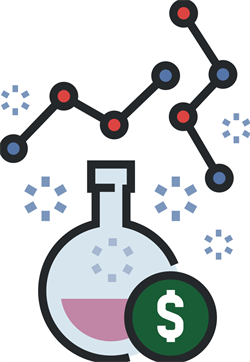
Scientists at UTMB have discovered a promising developing drug that has been shown to selectively shrink excess fat by increasing fat cell metabolism. The drug significantly reduces body weight and blood cholesterol levels without lowering food intake in obese mice. “As fat cells grow larger, they begin to overexpress a protein that acts as a metabolic brake that slows down fat cell metabolism, making it harder for these cells to burn accumulating fat,” said senior author
Dr. Stanley Watowich, associate professor in the Department of Biochemistry and Molecular Biology. “In addition, as the fat tissue expands, it secretes higher levels of hormones and pro-inflammatory signals that are responsible for several chronic diseases, including type 2 diabetes and cardiovascular disease.” The researchers discovered a molecule that blocks this metabolic brake from operating in obese white fat cells in order to increase its metabolism. In the study, mice were fed a high-fat diet until they became obese and then received either the drug or a placebo. Following 10 days of drug treatment, researchers found that the obese mice receiving the actual drug lost more than 7 percent of their total body weight, and their white fat tissue mass and cell size decreased by 30 percent compared with the placebo group. In addition, blood cholesterol in drug-treated mice was lowered to levels similar to that of non-obese mice. Placebo-treated mice continued to accumulate white fat and gain weight throughout the study. Interestingly, mice in both the drug-treated and placebo groups consumed the same amount of food during the course of the study period, showing that the fat loss was not due to appetite suppression. The findings have been published in Biochemical Pharmacology.

The most effective way of preventing the flu is to be vaccinated each autumn. Unfortunately, there are many different flu viruses circulating around the world and which ones circulate changes over time. Each year, pharmaceutical companies produce vaccines against the flu viruses predicted to be dominant during the upcoming flu season. How well the vaccine works varies from year to year because of how much the circulating flu viruses evolve between the time the vaccine is produced and the beginning of flu season. For this reason, in most years, the flu vaccine is 50 to 70 percent effective. During the Australian 2017 flu season, the flu vaccine was only 10 percent effective because of the emergence of variant H3N2 flu that was “vaccine resistant.” Scientists from UTMB and Biomed Protection published this prediction almost two years in advance, demonstrating that the prediction of flu vaccine efficacy may be possible. In a new paper published in F1000 Research, scientists used the same bioinformatics platform to determine how well the current seasonal flu vaccine might protect against H3N2 flu viruses isolated in the U.S and Australia between July and September 2017. The results suggest that the current flu vaccine will work better during the 2018 U.S. flu season than the 2017 Australian flu season. In Australia, there were two groups of H3N2 viruses circulating, and the vaccine was projected to protect against the minority of viruses but not the majority viruses. In the U.S., the vaccine is projected to be effective against the majority of H3N2 flu viruses so far. “Nevertheless, this situation could change if any of the viruses from the minority group, which is not covered by the vaccine, were to become dominant,” said
Dr. Slobodan Paessler, UTMB professor in the Department of Pathology. “For this reason, it’s very important that we closely monitor the evolution of the H3N2 flu viruses throughout the 2018 U.S. flu season.” Recently, lack of effectiveness in the flu vaccine has been linked to a specific mutation generated during the vaccine production process. The scientists analyzed the effect of the mutation and found that it is shifting the vaccine virus from the majority group to the minority group, potentially decreasing the vaccine’s effectiveness.
Compiled from press releases written by Donna Ramirez. Find out more at www.utmb.edu/newsroom.
 DID YOU KNOW?
DID YOU KNOW?
Throughout UTMB’s history, UTMB’s researchers have pioneered life-saving discoveries that continue to improve the health of people around the world. Now more than ever, our researchers’ work is being recognized, from engineering the world’s first Zika virus infectious clone to growing the first human lungs in the laboratory. The funding UTMB is garnering for its research initiatives is reflective of this success. Total research funding in FY2017 was $131,998,593, an increase of $7.4 million from FY2016. Sources of research funding include $92 million from the National Institutes of Health (NIH), as well as $8.2 million from the Department of Defense. UTMB also receives research awards from NASA, the Agency for Healthcare Research and Quality, the Health Resources and Services Administration and other federal agencies, as well as local and private organizations.